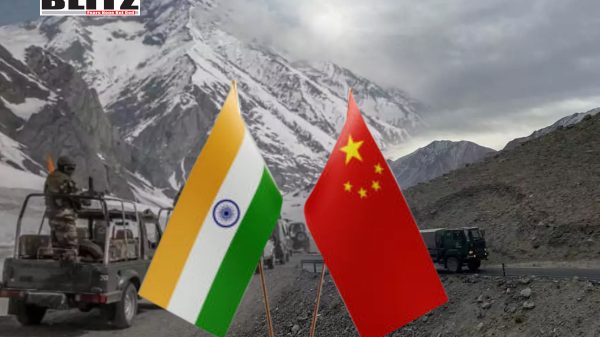India and China reach landmark deal on border dispute amid BRICS summit preparations
- Update Time : Wednesday, October 23, 2024

In a significant diplomatic breakthrough, India and China have reached a key agreement concerning the ongoing military standoff along their disputed border, known as the Line of Actual Control (LAC). This development marks a crucial step forward in de-escalating tensions between the two nuclear-powered neighbors, who have been locked in a four-year standoff since violent clashes erupted in the region in 2020. The announcement of the deal comes just days ahead of the BRICS summit in Russia, where Indian Prime Minister Narendra Modi and Chinese President Xi Jinping are expected to meet on the sidelines.
The long-standing border dispute between India and China, rooted in territorial claims along the 3,500-kilometer (2,100-mile) frontier in the Himalayas, has been a major source of friction between the two countries. Tensions boiled over in June 2020 when soldiers from both sides clashed in the Galwan Valley in Ladakh, resulting in the deaths of 20 Indian and four Chinese troops. The incident marked the deadliest confrontation between the two nations in decades and led to a deep freeze in diplomatic and economic relations.
Since then, both countries have engaged in over 30 rounds of military and diplomatic talks to resolve the standoff. However, despite multiple disengagements and de-escalation efforts, the situation along the LAC remained tense, with large deployments of troops, artillery, and military infrastructure on both sides.
The latest agreement, which was confirmed by Indian Foreign Minister Subrahmanyam Jaishankar on October 21, represents a significant shift in the trajectory of the standoff. According to Jaishankar, the two sides have agreed to revert to the situation that existed along the LAC prior to the 2020 clashes, effectively restoring the status quo ante in the disputed areas.
“The disengagement process with China has now been completed,” Jaishankar stated, adding that the deal was reached after several rounds of negotiations through diplomatic and military channels. “We have always said that if you disturb the peace and tranquility, how can the rest of the relationship go forward?” he remarked, emphasizing the importance of maintaining stability in the border areas for broader diplomatic engagement between the two nations.
As part of the agreement, both India and China have committed to monitor the Ladakh region closely to prevent further violations along the LAC. Indian Foreign Secretary Vikram Misri, who played a central role in the negotiations, confirmed that the two countries will continue to take “next steps” to ensure the agreement is fully implemented on the ground.
“The focus is on monitoring the area to prevent any further violations,” Misri explained, highlighting the importance of mutual trust and patience in reaching this point. “This agreement was the result of several rounds of discussions through diplomatic and military channels over the past few weeks.”
While there has been no immediate confirmation from Beijing regarding the agreement, Indian officials have expressed optimism about the potential for the deal to restore peace and stability in the border areas. Misri underscored that both nations will continue to engage through diplomatic and military avenues to resolve any outstanding issues.
The timing of the agreement, just ahead of the BRICS summit in Russia, could serve as a platform for further diplomatic engagement between Prime Minister Modi and President Xi. Both leaders are expected to hold a bilateral meeting on the sidelines of the summit, where they may discuss the broader implications of the agreement and explore ways to strengthen ties between their countries.
The resolution of the LAC standoff is a notable victory for Indian diplomacy, which has been pursuing a strategy of patient negotiation despite the severe strain that the border crisis placed on India-China relations. Foreign Minister Jaishankar acknowledged that many observers had doubted the possibility of a resolution, but he credited “persistent diplomacy” for achieving the breakthrough.
“This mutual understanding on patrolling will help to regain the peace and tranquility of the pre-2020 border areas,” Jaishankar noted, expressing hope that the agreement would lead to a more stable and constructive relationship between the two countries. “Hopefully, we will be able to return to that peace and tranquility.”
The agreement could also alleviate some of the economic tensions that have arisen between the two nations since 2020, with New Delhi imposing restrictions on Chinese investments and banning dozens of Chinese apps in response to the border clashes. A more stable border situation could pave the way for renewed economic cooperation between the two Asian giants, both of which are key members of the BRICS grouping.
Despite the positive momentum generated by the agreement, challenges remain. Indian Army Chief General Upendra Dwivedi has cautioned that while the situation at the border appears “stable” for now, it is still “not normal.” He stressed that the success of the agreement would depend on the actions of military commanders on the ground and their ability to enforce the terms of disengagement.
Dwivedi’s remarks underscore the complex and often unpredictable nature of the India-China border dispute. Although the two nations have agreed to disengage in certain areas, issues related to patrolling, military deployment, and the overall demilitarization of the region are likely to persist. Moreover, trust between the two militaries remains fragile, given the history of violent confrontations and repeated accusations of territorial violations.
There is also the question of how long the current agreement will hold. Previous deals between India and China have sometimes faltered due to misunderstandings or perceived provocations along the border. Skeptics may question whether this latest breakthrough will lead to a long-term resolution of the LAC dispute, or if it is simply another temporary truce in a conflict that has spanned decades.
The India-China agreement on the LAC is undoubtedly a welcome development after years of heightened tensions and uncertainty. It reflects the willingness of both nations to prioritize peace and stability in the border regions, even as broader geopolitical and economic rivalries continue to shape their relationship.
As the two countries prepare to engage further at the BRICS summit in Russia, the agreement serves as a reminder of the potential for diplomacy to resolve even the most intractable disputes. Whether this deal marks the beginning of a new chapter in India-China relations remains to be seen, but it is clear that both sides recognize the importance of maintaining peace and tranquility along their shared border.














Leave a Reply